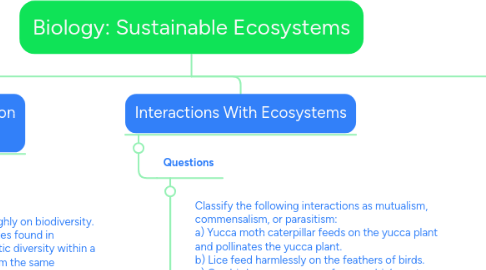
1. The Effects of Human Activity on Ecosystems
1.1. Impacts of Biodiversity
1.2. The health of an ecosystem depends highly on biodiversity. Biodiversity refers to the different species found in an ecosystem. It also refers to the genetic diversity within a species (for example, all humans are from the same species yet we all have differences).
1.3. If there is a decrease in biodiversity it would endanger the functioning of our ecosystems and the survival of organisms. Humans can greatly change an ecosystem and many of our actions have impacted biodiversity.
1.4. Questions
1.4.1. What is an aquaculture? Explain why aquacultures can be a solution to declining wild fish populations.
1.4.2. What is biomagnification? Which organisms are most affected by biomagnification in food chains?
1.4.3. Describe the stresses we have put on freshwater lakes in Ontario.
2. Interactions With Ecosystems
2.1. Questions
2.1.1. Classify the following interactions as mutualism, commensalism, or parasitism: a) Yucca moth caterpillar feeds on the yucca plant and pollinates the yucca plant. b) Lice feed harmlessly on the feathers of birds. c) Cowbird removes an egg from a robin’s nest and replaces it with one of its own. d) An orchid plant grows on the branch of a tree. The tree remains healthy.
2.1.2. A squirrel population grows in a forest until they reach their carrying capacity. What are some abiotic and biotic factors that limit the overpopulation of squirrels?
2.1.3. What is symbiosis? What are the 3 main types of symbiosis?
2.1.4. How do similar species that feed on the same prey coexist in an area together and avoid competition?
3. Ecosystems
3.1. Questions
3.2. Name and describe the 3 main components of the biosphere.
3.3. In the water cycle, what are two processes that cause water to enter the atmosphere?
3.4. How do animals get nitrogen?
3.5. Draw a food chain with at least 4 organisms labeling the producer, primary consumer, secondary consumer and tertiary consumer.
3.6. Why are decomposers important in an ecosystem? What are the major types of decomposers?
3.6.1. Review
3.6.2. Food Chains and Food Webs.
3.6.3. Energy Pyramids.
3.6.4. Photosynthesis/Cellular Respiration
